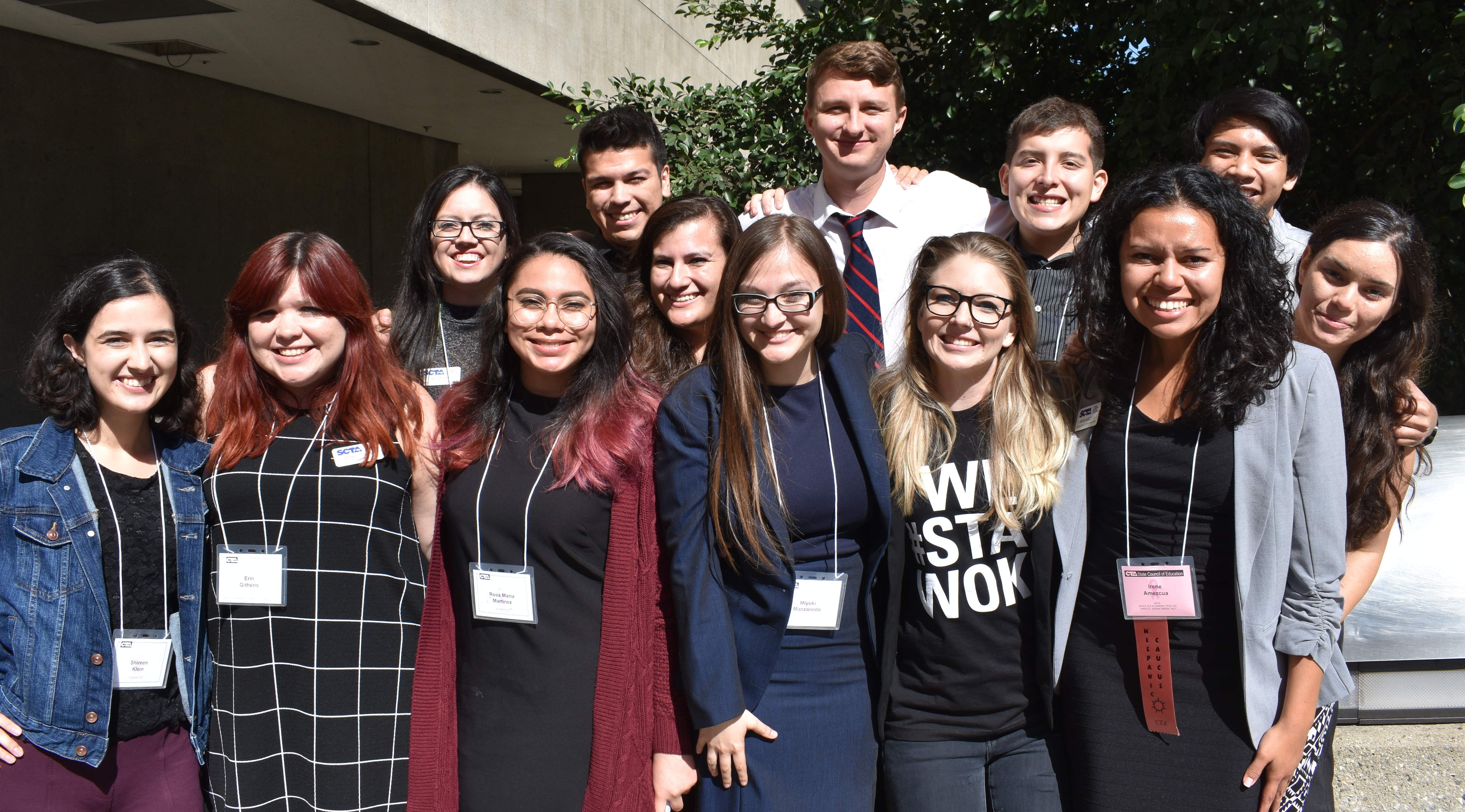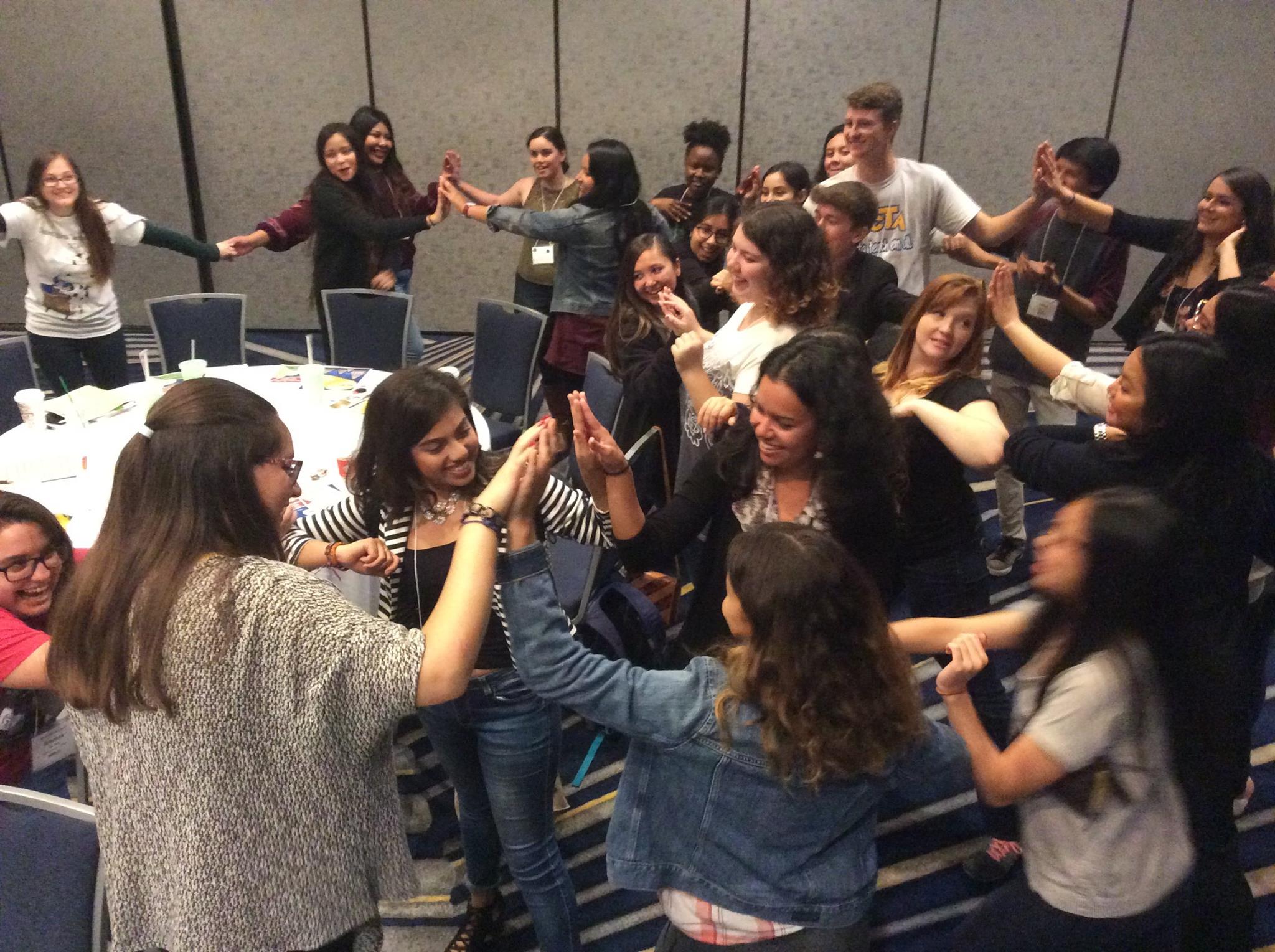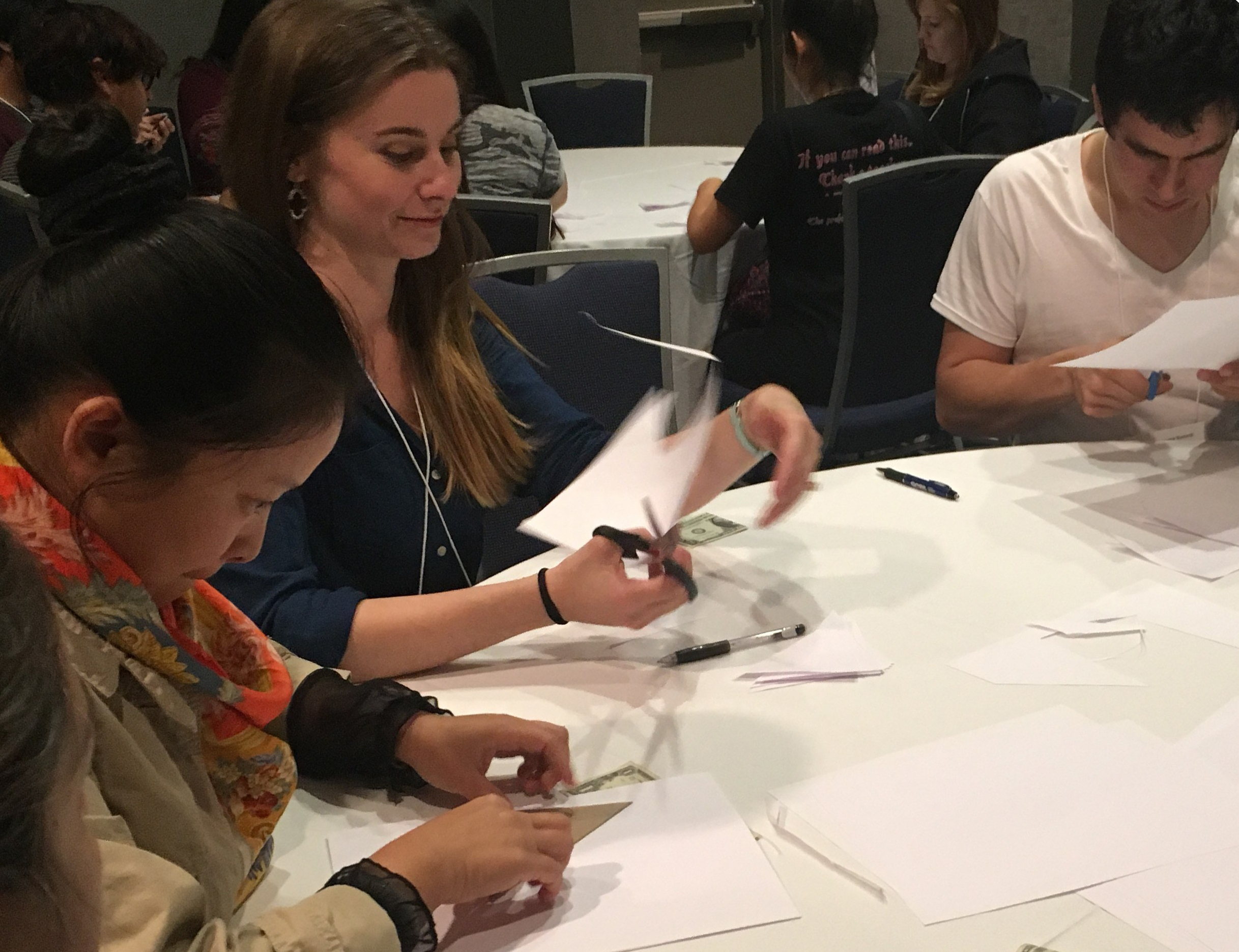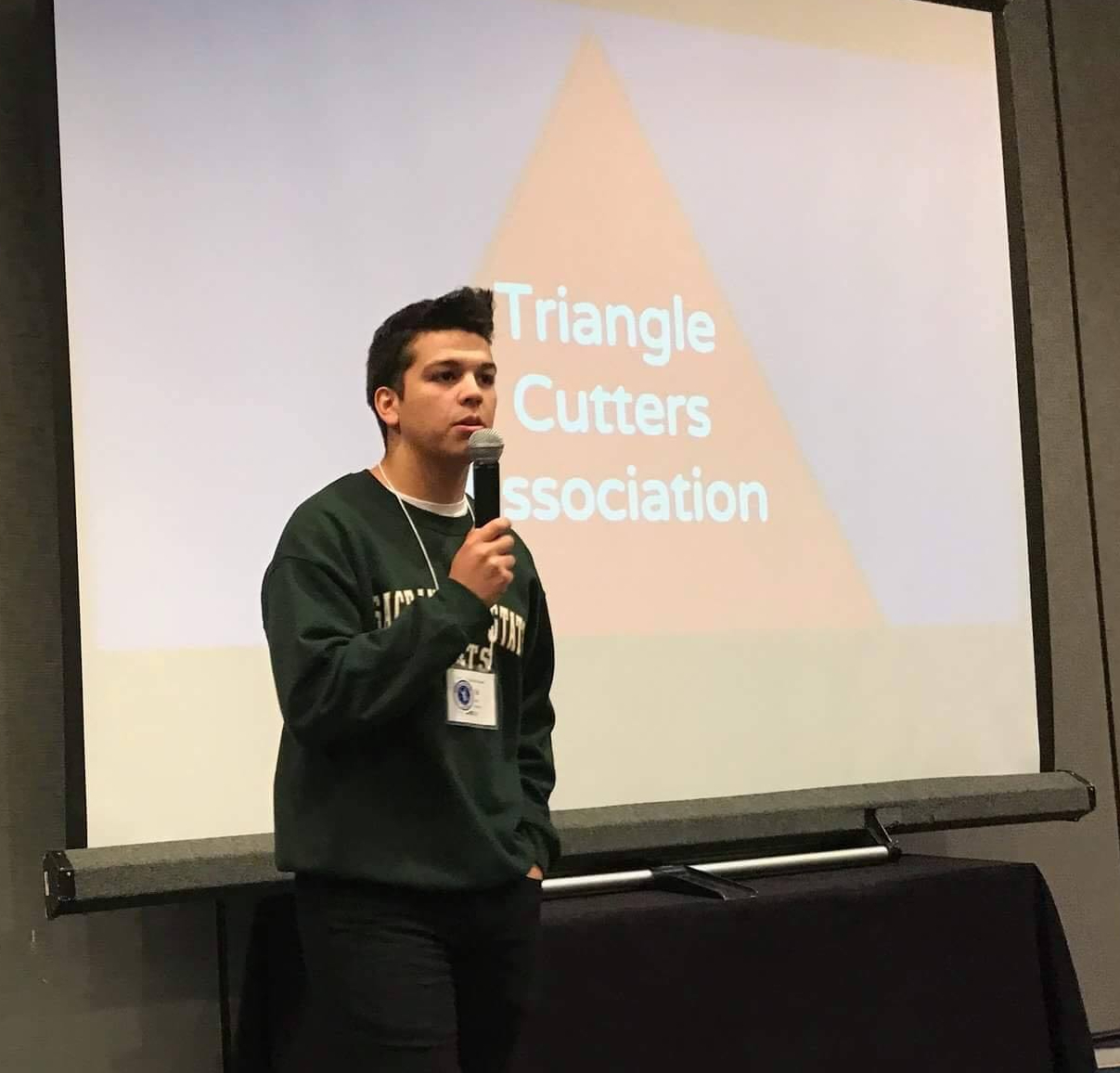Leave it to the young — in this case, Student CTA — to come up with fresh ways of thinking and doing.
SCTA Board members, in fact, developed an original event for their fall Welcome Summit, held in Irvine in early November, that deeply engaged new members and helped ensure that everyone has the opportunity to lead and contribute.
Among its goals this past year, the board wanted to strongly connect new members to SCTA’s social justice work and the multifaceted benefits of unionism, and to grow leaders and activists within its ranks. The board decided the best way to do this was to create an “experience” or “journey” with meaning and power, at a fall event that would draw members from across the state.

Student CTA Executive Board; front row: Shireen Klein, Erin Githens, Rosa Maria Martinez, Miyuki Manzanedo, Mackenzie Ramsay, Irene Amezcua, Autumn Crisantes; back row: Samantha Smith, Qohle Martinez, Stephanie Rios, Douglas Anderson, Abel Solano, Aaron Barlin.
The first thing they did was open the event to new blood. “Chapters always had elections to see who goes to the Fall Leadership Conference,” says Miyuki Manzanedo, SCTA president, noting that the same set of leaders would attend everything. “So our parameters for the event were that it was for members who were not part of chapters, and chapter members who had never been engaged before.”
Next, they ditched the conventional conference setup, because they felt it does not foster enough connection between and among people. “When we came up with ideas, it was ‘No workshops!’” says Manzanedo. “Members felt they were being lectured at. We wanted to move away from general sessions with a guest speaker.”

Student CTA Welcome Summit icebreaker.
The weekend summit included some necessary activities:
Relationship-building. Participants were separated from people they knew, so they could forge new connections. SCTA Board members, with the exception of Manzanedo, were not introduced as such till the end of the event, so they could be considered regular members and new leaders could emerge. Through various exercises, individuals learned about each other and forged tight bonds.
“It made me realize that in school we sometimes forget to learn about our students, and that could change everything,” says Krystal Perez, a student at Sacramento State University. “When we allow students to feel safe, they are more open to learn.”
Exploration of biases in education. Participants discussed disparities in student outcomes, and how, since the American public education system was originally meant to serve certain groups, inequities have been addressed over time with add-ons instead of rethinking or revamping the entire system.
“We were concerned that people wouldn’t grasp the concept of fair share. But when they went into a room to discuss forming a giant union, it made my heart feel full.” – Student CTA President Miyuki Manzanedo
The journey
Then, the summit program turned to unionism and the potential impact of the Janus v. AFSCME case currently before the U.S. Supreme Court.
Participants were all given the same scenario: You’re a poor college student who can’t take out any more loans. It’s critical that you have a job to pay for school and support your family. And good news — you just got a job, cutting triangles for a corporation. Now, go to your new employee orientation.
Participants headed off to one of four different “corporate headquarters,” where their “boss” laid out job expectations, such as no talking and no cellphones, and tardiness would result in not being paid. Then, for purposes of the journey, 10-minute periods became a workday (with six minutes of work and four minutes off), and conditions became increasingly challenging. Some bosses were mean and belittled workers; others set high quotas for number of triangles cut; others supplied faulty scissors, inadequate templates, etc. Bosses could make workers work overtime without pay. A “big boss” came in to put pressure on the local bosses. Cards that would affect individuals were randomly distributed; for example, one card indicated that you cut your hand, but since you can’t quit or leave, you had to cut with your other hand.
 SCTA organizers had no way of knowing how the journey would progress, and indeed some participants grew angry. But all “employees” eventually found their working conditions unacceptable and talked of unionizing. All four groups ended up forming unions the first day of the program.
SCTA organizers had no way of knowing how the journey would progress, and indeed some participants grew angry. But all “employees” eventually found their working conditions unacceptable and talked of unionizing. All four groups ended up forming unions the first day of the program.
Gail Watts, Regional UniServ Staff for CTA Human Rights, played the role of outside union organizer advising the nascent activists as they negotiated their first contracts. “Some wanted a lawyer to negotiate for them,” Watts says. “I told them, ‘No, union members negotiate their own contract. Lawyers charge $150 an hour — do you have the funds for that?’”
As leaders thought through what they wanted in the contract, she reminded them to keep the broader membership in mind. “Are you being inclusive on holidays you want off? What happens when bosses come back with counter offers?”
“It was pretty intense. I now have an understanding of education and school system. It was a good experience for real life.” – SCTA Welcome Summit participant Amy Lo
‘I called my parents’
The next day of the journey, the four groups held official union meetings to elect leadership, establish core values, and decide what to focus on. Each 10 minutes was still a workday, but four minutes of the day was devoted to “society,” where workers left their rooms for a common area marked with anti-union posters and messages. At one point during society time, the Supreme Court decided in favor of Janus, meaning that no one needed to pay fair share fees to unions anymore.
SCTA organizers had “plants” out in society who tried to convince the now-unionized workers to leave the union — and then have them organize to convince others to leave. Back at their jobs, union members would have to try to get those who had left the union back into the fold, to maintain solidarity and their bargaining power with bosses.
 At one of the final society moments, Manzanedo played the role of an anti-unionist, jumping on a chair to give an impassioned speech to the crowd. “I told them they didn’t need unions. I tried to open their eyes: ‘What are unions using your money for? For things you don’t like! Your money is going for candidates you don’t support.’”
At one of the final society moments, Manzanedo played the role of an anti-unionist, jumping on a chair to give an impassioned speech to the crowd. “I told them they didn’t need unions. I tried to open their eyes: ‘What are unions using your money for? For things you don’t like! Your money is going for candidates you don’t support.’”
But it backfired. The entire group of workers decided to join in one giant union.
“It was so exciting for me. We were concerned that people wouldn’t grasp the concept of fair share. But when they went into a room to discuss forming a giant union, it made my heart feel full. I called my parents,” says Manzanedo, whose parents are longtime educators and CTA members.
Spreading the word
The journey had a powerful impact on participants.
“It was pretty intense. Some people took things very seriously,” says Amy Lo, currently studying at Santa Ana College. “It was a good experience for real life. And I now have an understanding of education and the school system.”
“It taught me about equality, equity and workers rights,” says Perez. “I had never thought about all the rights that were earned through unions for workers before. The way that the roles were played was very realistic and it was impactful because people were passionate and stated facts. People stood on chairs, shouted, and lobbied.”
“We had a couple members share out responses,” says Manzanedo. “They said things like ‘This was the most amazing experience of my life’ and ‘I will never forget this.’”
Watts says she met up with two participants at a later CTA conference, who were still talking of how meaningful the experience was.
Watts is proud of the SCTA Board and the event they pulled off. “I’m extraordinarily happy that the SCTA Board was willing and able to try new things,” she says. “They developed an event that matched their goals, and had a comfort level with creating scenarios and not knowing how they would turn out.”
She thinks there are lessons to be learned from SCTA’s successful event, particularly given what may happen following the Supreme Court’s Janus decision. “CTA members have to be inoculated [with unionism] because they’ll be inundated with anti-union messaging.”
The SCTA Board met at CTA’s January State Council in Los Angeles to debrief and consider whether the event accomplished its goals and what to do next. Many thought the experience was powerful enough to continue. The board next meets at SCTA Representative Assembly in April.
Manzanedo, meanwhile, is busy spreading the word about SCTA, asking local presidents for a few minutes at their meetings to talk about SCTA. “My parents didn’t know SCTA existed till I joined,” she says. “How can they not have heard about it?”
Bringing Policy to Life
At SCTA Representative Assembly last April, the board created an education experience for attendees in two rooms set up like a museum, with quotes from U.S. Education Secretary Betsy DeVos and others, along with images and documents. Attendees would pick one of 20 “identities” that would inform their journey through the exhibit — for example, you might be a third-grade student with special needs, or a first-year teacher.
Events that occurred along the journey — such as the cutting of federal funds for a school lunch program — would affect your experience. The journey brought policy to life, and was so well received that it became the basis for the Welcome Summit in the fall.
Student CTA
Members: About 1,300
Benefits: Members receive $1 million liability insurance, which covers them when they work with students as a requirement for a class or program; discounts to attend CTA conferences; networking with other aspiring educators; sponsorship and volunteer opportunities to SCTA events and some CTA conferences.
Board: Members are elected to one-year terms.
Social media: Facebook.com/StudentCTA
The Discussion 0 comments Post a Comment